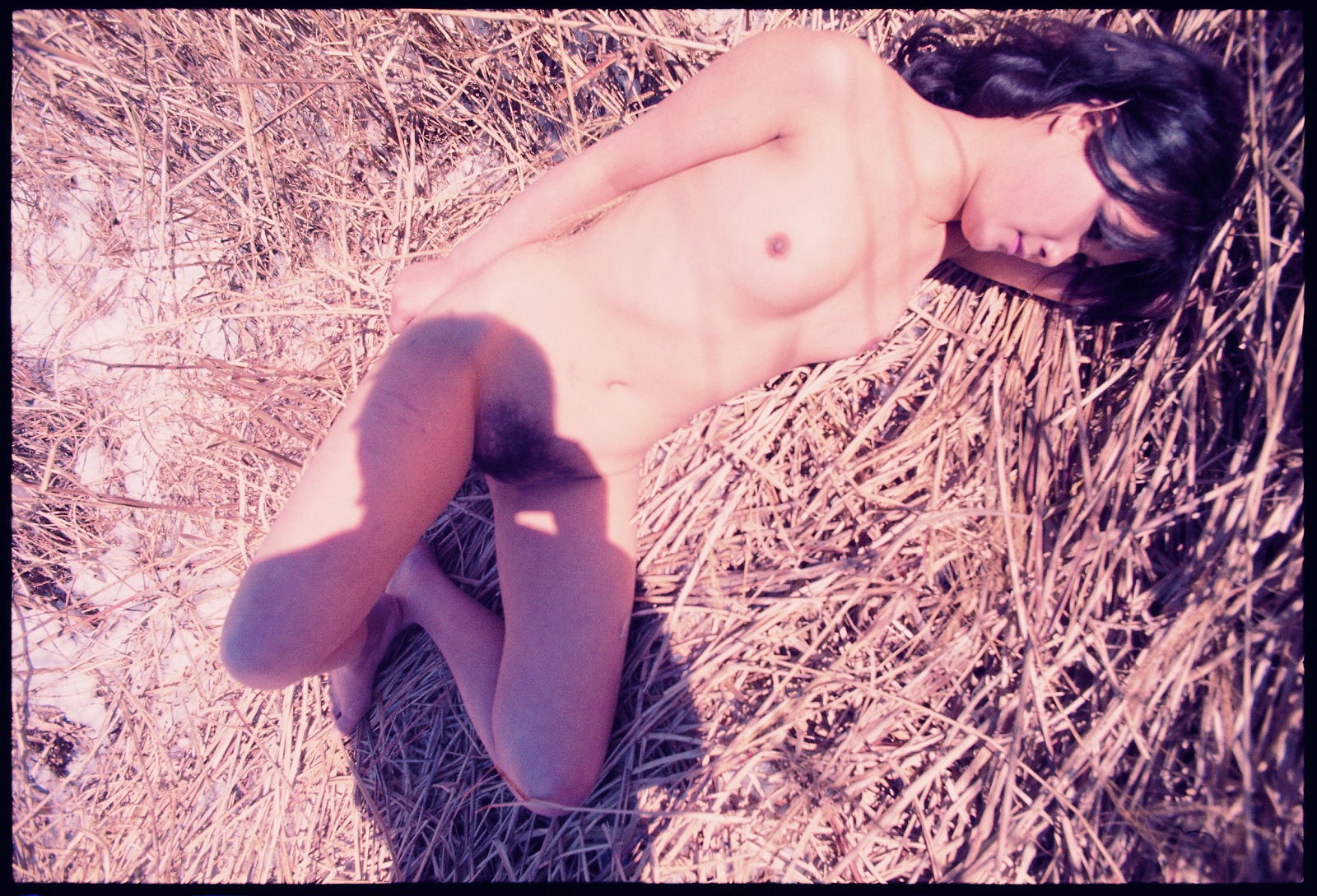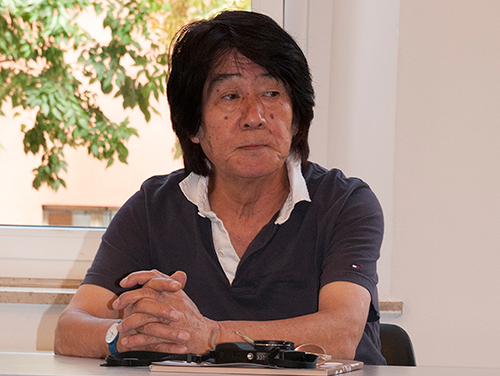daidō moriyama
Moriyama in color*
«[...] I do not know, maybe I am waiting for someone or maybe I am going to go home. I am alone and remain motionless. In the sand-filled hole are buried broken shadows of people. The land is dry and rough and there are cold sounds. Perhaps the sound of a swing that moves back and forth or a song that someone murmurs in the distance, or birds singing. The sunset seems endless, it never gets dark»**
Ryu Murakami
Rome. Summer. A little more than thirty years ago. On an outdoor stage a group of young people walk slowly following trajectories that consume space. A man watches them carefully. I am struck by the thinness of his responsive physique and shaved head, which reflects the light that rains down in the large courtyard.
The young people shuffle their feet on the wooden boards, knees slightly bent, pelvis thrust forward, soft arms along their body. When they meet they emit a little unconvincing cry. Kō Murobushi (1), the man without hair who watches them, stops everyone. They must not be shy, he explains. Kiai (2) must start from the solar plexus, be strong. Practicing martial arts I know that kiai allows you to ... encounter the energy, which flows in our body, concentrate it and release it in the attack. But what has this got to do with dancing?
As if he could read my thoughts, Murobushi explains that in Butō (3) kiai is not needed to attack each other. In contrast it allows it to encounter in the crossing of the infinite possible trajectories that flow in space.
That wandering without predefined direction on the stage is not far from being a metaphor. That of a human condition which we often see moving in the illusion to determine our direction, when in fact we suffer the effects of a kind of clinamen (4) that arbitrates our existence.
This small piece is detached from the mosaic of my memory and resurfaces every time my eyes meet the images of Daidō Moriyama. Analogous results metaphorical, even in its concreteness, I feel it in fact in Moriyama’s roaming in the streets of the world. A continuous and never-ending search for the meaning of that mystery constituted by reality itself with, on the one hand, the external stimuli that come from the world and, on the other, the internal ones originating from the mnemonic experience. Moriyama is conscious of the flow of a relentless exchange between himself and the world. He refrains from judgment, but at the same time he does not limit himself to reproduce what he encounters. His inquisitive camera is a participant of the process and it moves in fact on tracks that intertwine continuously the real contemporary and a past made present from memory. The photographic gesture, then invades into the flow of exchange between the reality and the author, sanctioning the meeting of the latter with otherness. The action of taking the photographs fulfils the role of the kiai in the exercise proposed by Murobushi, connecting ki individually with that universe. A duality that dissolves dissolving in that split second in which the shutter allows the light to pass through, in that instant in which the professional wanderer merges with the interiority traveller. (6)
[ Sandro Iovine ]
--------------------------------------------
(*) - The exhibition Moriyama in Color is on display in Modena at the Foro Boario, via Bono da Nonantola 2, from 6th March to 8th May 2016.
(**) - Ryu Murakami, Park, in Tokyo Decadence, Arnoldo Mondadori Editore, Milan, 2004; p. 26.
(1) - Kō Murobushi (1947 - 2015) was considered the heir to Tatsumi Hijikata of which he was a student, and has the merit of having made Butō known in Europe.
(2) - The 気合い (kiai) accompanies the attack in combat and emphasizes the moments of greatest concentration in kata. The term is composed of the kanji 気 (ki) and the indefinite base of the verb 合う (au). The 氣 (気 in the simplified spelling of the kanji) indicates the vital energy that pervades living organisms. The verb 合う (au) instead means encountering.
(3) - The 舞踏 (butō) is a form of contemporary dance developed in Japan in the fifties of the work mainly by Tatsumi Hijikata and Kazuo Ōno. It is not codified in a univocal form of representation, but it shows a number of common features such as the exposure of the body, the fact that it is painted white, and the expressiveness sometimes grotesque and often tragic that has its roots in the classical Japanese theatre.
(4) - Clinamen is the term that Lucrezio translates παρέγκλισις (parénklisis), word with which, in the Epicurean physics, shows the spontaneous deviation that allows atoms to meet.
(5) - Moriyama in the collection of essays Inu no Kioku (Memories of a dog) makes a comparison between two poets, famous for their haiku, who lived during the Tokugawa Jidai (1603 - 1868): Matsuo Bashō (1644 - 1694) and Yosa Buson (1716 - 1784), defining the first a professional wanderer and the second an interiority traveller.
(6) - Akira Hasegawa, in Daidō Moriyama, Visioni del Mondo, Skira, Milan 2010; p. 19.
_ _ _
[ INTERNAL RESOURCES ]
◉ [ exhibitions ] Moriyama in Color: the exhibition

 home
cover ▼
opinions
news ▼
portfolio
post.it
post.cast
video
ongoing
thematicpaths
googlecards
FPtag
home
cover ▼
opinions
news ▼
portfolio
post.it
post.cast
video
ongoing
thematicpaths
googlecards
FPtag











 Hiromichi "Daidō" Moriyama* - Born in Ikeda in the prefecture of Ōsaka in 1938, is one of the major photographers who has contributed to the transformation of the photographic language eradicating classical aesthetic rules. Among his teachers Shomei Tomatsu, the photographer closest to him to listen to, and Eikō Osoe, of which he was also assistant. In 1968, he lived the revolutionary editorial experience of the Provoke magazine first hand, which published just three numbers, but it left a tangible sign in the conscience characterised by the idea that «the world is not how we think we know it a priori». Among his most important works we remember Japan: A Photo Theatre (1968), Accident (1969), Kakudo (1972), Shashin yo sayōnara (1972), a kind of manifesto for the destruction of the photographic standards in force previously, Cherry blossom (1974), Tono Monogatari (1974), Hikari to kage (1982) and Memories of a Dog (2004), a collection of photographs and essays published in Asahi Camera.
His works are kept at the Museum of Modern Art in New York, the Metropolitan Museum of Art, the San Francisco Museum of Modern Art, the Getty Museum in Los Angeles, the Museo of Fine Arts in Boston and the Centre Pompidou in Paris.
Hiromichi "Daidō" Moriyama* - Born in Ikeda in the prefecture of Ōsaka in 1938, is one of the major photographers who has contributed to the transformation of the photographic language eradicating classical aesthetic rules. Among his teachers Shomei Tomatsu, the photographer closest to him to listen to, and Eikō Osoe, of which he was also assistant. In 1968, he lived the revolutionary editorial experience of the Provoke magazine first hand, which published just three numbers, but it left a tangible sign in the conscience characterised by the idea that «the world is not how we think we know it a priori». Among his most important works we remember Japan: A Photo Theatre (1968), Accident (1969), Kakudo (1972), Shashin yo sayōnara (1972), a kind of manifesto for the destruction of the photographic standards in force previously, Cherry blossom (1974), Tono Monogatari (1974), Hikari to kage (1982) and Memories of a Dog (2004), a collection of photographs and essays published in Asahi Camera.
His works are kept at the Museum of Modern Art in New York, the Metropolitan Museum of Art, the San Francisco Museum of Modern Art, the Getty Museum in Los Angeles, the Museo of Fine Arts in Boston and the Centre Pompidou in Paris.